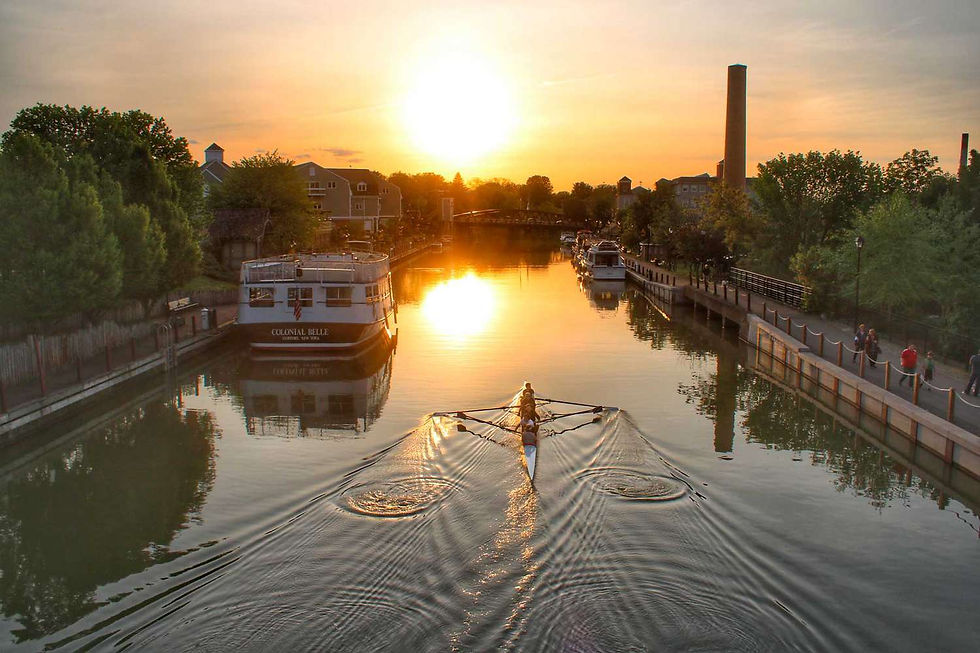"I rejoice sincerely in the progress of your canal, and envy your location in a state wise enough to see that the common interest is individual interest, and rich enough to pursue it."
-Thomas Jefferson to Gov. Dewitt Clinton, 1822
Starting the morning wincing a little as I type. Last week the sport of golf inflicted yet another injury on me, this time physical rather than psychological, when I pulled something in my left forearm up to the inside of my elbow when I whacked the ground behind the ball with a long fairway iron. A couple trips to the weight room in the days that followed didn't help. Now every keystroke brings a twinge, and I'm reminded of just how much more I use my left hand than my right in most activities of daily living. I invested in some lidocaine rub in Roanoke when Peg's sciatica almost ended our vehicle caravan from Florida to New York--maybe I ought to slather some on now.
I'd planned this morning to ruminate a little on who pays for the federal government and who benefits, viewing the issue by state and figuring the north subsidizes the south. But it's not so simple as that. If one looks at the revenue side, states like California, New York, Texas, Florida, and Illinois pay over far, far more income taxes than, say, Vermont. But if you look at whether a state gets back a dollar, or less or more, for every dollar its citizens drop into the pot, the map becomes a checkerboard, largely a function of whether a state rejected Medicaid expansion, as near as I can tell.
The same holds true for grant payments to local governments.
But doesn't the south benefit disproportionately from defense spending? It depends on what you mean by that. If you're talking about retiree benefits and payroll, there's some truth to the premise. If you look at the checks the feds write for procurement, however, the picture shifts and the big winners are Virginia, Texas, California, Florida, and New York.
So I gave up on that analysis, which gets awfully complicated for this little writing exercise.
Instead, I found myself thinking about the book in which I'm immersed this week, Heaven's Ditch: God, Gold, and Murder on the Erie Canal, by Jack Kelly. The book chronicles two parallel and intertwined events in the 1820s, the creation of the Erie Canal and the Second Great Awakening. A lot of folks don't realize the LDS Church began just up the road from our condo, right outside of the village of Palmyra, New York. You can still visit the hill where Joseph Smith claimed to have found the Golden Tablets, and the forest where he supposedly encountered Yahweh himself, alongside Jesus. Kelly's sympathetic portrayal of Smith can't mask the fact that he was sort of a huckster and a satyromaniac, but apparently so charismatic that he just sort of drew people to himself and his odd, odd religion.
Meanwhile, in the midst of a religious revival that swept across this part of the country during that decade, New York started work on what was derisively labeled "Clinton's Big Ditch", after the Governor who's vision led to its creation. The Erie Canal was an absolute marvel of its day, 363 miles long and moving freight and people over nearly 600 feet of elevation change between Lake Erie and the Hudson. It created an economic boom first across western New York and then all the way across the Great Lakes, opened the "West" to migration on a mass scale, and allowed a Buffalo restaurant patron to dine on fresh raw oysters from Long Island Sound only a few days after they were harvested.
Oh, and the Empire State paid for the whole thing itself, the feds not being terribly interested at the time in a project Thomas Jefferson once derided as "little short of madness". It turned out to be quite an investment, breaking even in its first year of operation and eventually becoming sort of a cash cow for the state through the tolls collected along the way.
Eventually the canal fell into obsolescence with the advent first of railroads and then truck transport. The rotting keelboat lying in an abandoned section of canal Peg and I stumbled across outside of Rome in the fall of 2020 had certainly seen better days.

But guess what? The canal's been largely re-routed, and to my surprise is still an active waterway, although these days it's mostly for tourists and pleasure boats making their way from Lake Erie to the Hudson.

With the condo (Peg's taken to calling it the "Cliff", a reference to its spectacular perch over Canandaigua Lake) only about a half-hour from the canal and all the history one can still find along its shores, I figure we'll have plenty to see and experience up that way over the balance of our lives.
I need to lean into a big filing that's due today in one of my cases, so I'm locked and loaded when Peg gets home from work. It's Memorial Day weekend, and we're headed up to the condo with a side trip on Saturday to pick up a boat that seems ideal for the new getaway. Fingers crossed the old girl starts and stays watertight on her shakedown cruise across our beloved new lake.
Comments